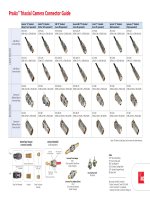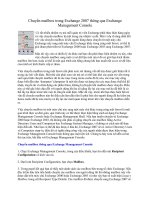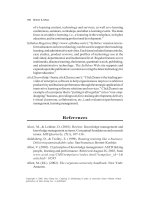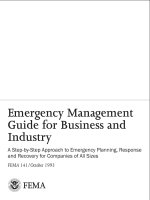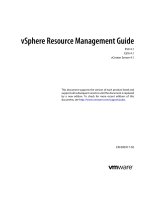YELLOW STARTHISTLE MANAGEMENT GUIDE pdf
Bạn đang xem bản rút gọn của tài liệu. Xem và tải ngay bản đầy đủ của tài liệu tại đây (7.85 MB, 78 trang )
JOSEPHM.DITOMASO
WeedScienceProgram,DepartmentofPlantSciences
UniversityofCalifornia,Davis
GUYB.KYSER
DepartmentofPlantSciences,UniversityofCalifornia,Davis
MICHAELJ.PITCAIRN
BiocontrolProgram,IntegratedPestManagementBranch
CaliforniaDepartmentofFoodandAgriculture,Sacramento
Publishedbythe
CaliforniaInvasive
PlantCouncil
September2006
YellowStarthistle
Management
Guide
USArmyCorps
ofEngineers
Engineer Research and
Development Center
YSTMgmt(FINAL).indd 1 10/12/06 12:49:19 PM
ACKNOWLEDGEMENTS
Development of this management guide was one of the long-term goals of a re-
searchdemonstrationprojectonIntegratedWeedManagementofYellowStarthistle
atFortHunterLiggett,CA.TheauthorsaregratefultotheDepartmentofDefense
LegacyResourceManagementProgramforpartialfundingthroughLegacyProject
ModelInvasiveSpeciesControlProject:YellowStarthistle(LegacyProject#01-160
and03-160)underMIPRW31RYO30983808,andtheU.S.ArmyEnvironmental
Center for their financial support of the project, and to the Western Integrated
PestManagementCenter“IPMIssues”programfortheirfinancialsupportofthe
preparationandpublicationofthismanagementguide.
Theauthorsalsothankthemanypeoplewhoassistedinthedevelopmentand
completionoftheFortHunterLiggettproject.Dr.StevenR.Bennett,U.S.Army
Environmental Center, provided leadership on the the project’s vision and orga-
nization.Dr.AlCofrancesco,U.S.ArmyCorpsofEngineers,EngineerResearch
andDevelopmentCenter,andDr.HerbBolton,U.S.DepartmentofAgriculture,
CooperativeStateResearch,Education,andExtensionServiceliaisontotheU.S.
ArmyEnvironmentalCenter,assistedwithtechnicalcoordinationfortheproject.
Mr.KennethSpencer,formerIntegratedTrainingAreaManagementCoordinator
and Mr. Arthur Hazebrook, Integrated Training Area Management Coordinator,
U.S. Army Combat Support Training Center, Fort Hunter Liggett Training Site
providedlogisticalassistanceandmuchoftheresearchatFortHunterLiggett.Don
Joley and Baldo Villegas of the California Department of Food and Agriculture,
BiologicalControlProgram,assistedwiththereleasesandmonitoringofthebio-
logicalcontrolinsects.DaleWoodsandViolaPopescu,alsowithCDFA’sBiological
ControlProgram,performedthereleasesoftheMediterraneanrustdiseaseatFort
Hunter Liggett. We also thank Jessica Miller for her diligent work on her M.S.
degreestudyingyellowstarthistleatFortHunterLiggett.
RECOMMENDEDCITATION
DiTomaso,J.M,G.B.Kyser,andM.J.Pitcairn.2006.
Yellowstarthistlemanagementguide.Cal-IPCPublication2006-03.
CaliforniaInvasivePlantCouncil:Berkeley,CA.78pp.Available:www.cal-ipc.org.
CONTACTINFORMATION
Toobtaincopiesofthisreport,contactthe
CaliforniaInvasivePlantCouncilthroughitswebsite,www.cal-ipc.org.
EditedbyDougJohnsonandElizabethBrusati,Cal-IPC
PhotosbyJoeDiTomaso,UCDavis,unlessotherwisenoted
DesignedbyMelanieHaage
Copyright©2006byCaliforniaInvasivePlantCouncil
YSTMgmt(FINAL).indd 2 10/12/06 12:49:21 PM
Chapter1.IntroductionandSpread............1
IntroductiontoNorthAmerica.........1
SpreadandDistributioninCalifornia ......1
SpreadtoOtherStates .............2
MechanismsofSpread .............3
Chapter2:Impact.....................4
Economics....................4
Rangelands ...................4
ToxicitytoHorses................5
RoadsidesandRecreationalAreas ........5
Wildlands....................6
WaterConsumption ...............6
BeeIndustry ...................7
Chapter3:BiologyandEcology..............8
TaxonomyandIdentification ..........8
Reproduction..................8
GerminationandDormancy ...........11
GrowthandEstablishment...........12
Light,Temperature,andWaterUsePatterns..14
Management ...................16
Chapter4.MechanicalControl .............17
HandPullingorHoeing.............17
Tillage......................18
Mowing .....................19
Chapter5.CulturalControl...............21
Grazing......................21
PrescribedBurning................23
Revegetation...................27
Chapter6.BiologicalControl..............32
NaturalEnemiesAssociatedwith
YellowStarthistleControl...........34
CurrentStatusofYellowStarthistleBiological
Control.....................36
ChoiceofBiologicalControlAgents.......37
MethodsandTiming ...............37
MonitoringSeedHeadInsects..........38
Economics....................39
Risks.......................39
Chapter7.ChemicalControl ..............41
Economics....................41
MethodsandTiming ...............41
HerbicideApplicationTechniques ........49
Risks.......................50
Chapter8.DevelopingaStrategicManagementPlan.. 53
Prevention .................... 53
Eradication ................... 54
DevelopingaManagementStrategy ....... 54
ImplementingaStrategicPlan ......... 59
ExamplesofIntegratedManagementStrategies 59
Conclusion .................... 63
LiteratureCited.................... 64
Tables
Table1.Comparisonofgrazingcharacteristicsof
cattle,sheep,andgoats..............22
Table2.Distribution,impacts,andpublications
onyellowstarthistleseedheadinsects...... 33
Table3.Commonlyusedherbicides........... 42
Table4.Summaryofcontroloptions .......... 55
Figures
Fig.1.ExpansioninCalifornia. .............2
Fig.2.Soilmoistureunderyellowstarthistlecompared
toannualgrasses...................2
Fig.3.Viableseedproductioninrelationtoflowering
stage.........................11
Fig.4.Seedbankinrelationtoyearlyrainfall.......11
Fig.5.Germinationinrelationtorecentrainfall.....11
Fig.6.Declineinseedbank. ............... 11
Fig.7.Growthofrootsandrosettes............ 13
Fig.8.Effectofsoildepthoncover. ........... 14
Fig.9.Effectofshadingonrootgrowth.......... 14
Fig.10.Effectofshadingonrosettegrowth. ...... 15
Fig.11.Effectofsunlightonbiomassproduction. ...15
Fig.12.Effectofmowingheightonseedheads. .... 19
Fig.13.Effectofcoveronbranchinghabit........ 20
Fig.14.Effectofburningoncover............24
Fig.15.Effectofburningonsoiltemperature...... 25
Fig.16.Effectofburningonseedbank.......... 26
Fig.17.Competitionwithperennialgrasses.......26
Fig.18.Effectofinsectcontrolagentsonseedproduction. 35
Fig.19.Late-seasoncontrolwithglyphosateandtriclopyr.45
Fig.20.Effectofclopyralidrateandtimingonforage
andyellowstarthistle.................46
Fig.21.Effectofstandinglitteroncontrolwithclopyralid.48
Fig.22.Effectivenessofclopyralidwithrevegetation...60
Fig.23.Effectivenessofburningintegratedwith
clopyralid....................... 61
Fig.24.Effectofburning+clopyralidonannualgrasses.62
Fig.25.Effectivenessofburningfollowedbyclopyralid
treatment........................62
Contents
YSTMgmt(FINAL).indd 3 10/12/06 12:49:21 PM
YSTMgmt(FINAL).indd 4 10/12/06 12:49:21 PM
YELLOWSTARTHISTLEMANAGEMENTGUIDE | 1
IntroductiontoNorthAmerica
T
hecenteroforiginofyellowstarthistle(Cen-
taureasolstitialisL.)isbelievedtobeEurasia,
whereitisnativetoBalkan-AsiaMinor,theMiddle
East, and south-central Europe (Maddox 1981).
Its introduction into NorthAmerica probably oc-
curredinCaliforniaafter1849asaseedcontami-
nant in Chilean-grown alfalfa seed, known then
asChileanclover(Gerlachetal.1998).Historical
records indicate that alfalfa was first introduced
toChilefromSpaininthe1600sandfromChile
toCaliforniaatthetimeofthegoldrush.Despite
itsSpanishorigins,alfalfacametoCaliforniaonly
fromChilebefore1903.After1903,itislikelythat
alfalfa was also introduced from Spain, France,
Italy,andperhapsTurkestan.
SpreadandDistributioninCalifornia
Ithasbeenspeculatedthattheintroductionofyel-
lowstarthistleintoCaliforniaoccurredinmultiple
steps(Gerlach1997a,b).Thefirstreportofalfalfa
cultivationwasnearMarysville,California,in1851.
Beforethe1870salfalfawasgrownprimarilyalong
riverleveesnearSacramento,Marysville andSan
Francisco.Theseareaswerecharacterizedbydeep,
well-drainedsoilsandeasyaccesstodrinkingand
irrigationwater.Bothanimalandalfalfaforagewere
distributedonlyshortdistances.Asaresult,yellow
CHA PT ER 1 : IntroductionandSpread
Worldwidedistributionofyellowstarthistle.Maddox
etal.1985.
starthistle infestations that accompanied alfalfa
stands were fairly localized. From 1870 to about
1905 much of the surrounding areas previously
consisting of dry-farmed wheat and barley fields
wereconvertedtobothdrylandandirrigatedalfalfa
fields.Duringthisperiod,yellowstarthistleestab-
lishedasdenselocalpopulationsintheseareasand
alongadjacent roadsides.Theuseoftractorsand
other equipment spread starthistle seed to other
locations, including grain fields. Gerlach (1997a)
indicatesthatyellowstarthistleinCaliforniaprob-
ablydecreasedbetween1920and1940,mostlikely
duetochangesincropproductiontechniquesand
thewidespreaduseofinorganicherbicides,suchas
DistributionofyellowstarthistleinCalifornia.
This2002map,basedonsurveydatabytownship,
illustrateshowwidespreadtheplantisinthestate.At
14millionacres,itisCalifornia’smostwidespreadweed.
DatacollectedbytheCaliforniaDepartmentofFoodand
Agriculture.(Pitcairn,Schoenig,YacoubandGendron2006)
YSTMgmt(FINAL).indd 1 10/12/06 12:49:22 PM
SpreadtoOtherStates
Introduction of yellow starthistle from California
to other western states occurred in the 1870s
and 1880s (Gerlach 1997a, Roché 1965). The
first report outside of California was in Bingen,
Washington (Sheley et al. 1999b).These first in-
troductionswerealsolikelythroughcontamination
sodiumarseniteandsodiumchlorate,alongroad-
sides.However,aroundthe1930sor1940syellow
starthistle began to invade foothill grasslands on
bothsidesoftheCentralValley.Inthisway,yellow
starthistlebecameanintegralpartofthegrazing/
weed dynamicoftherangeland system,inwhich
wildlife and livestock participated in the spread
oftheplant.By1958,theweedwasestimatedto
haveinvaded overone millionacresinCalifornia
(MaddoxandMayfield1985).
Sincethe1960s,threefactorshavecontributed
greatly tothefurtherspread ofyellowstarthistle:
anextensiveroadbuildingprogram,increasedsub-
urbandevelopment,andexpansionintheranching
industry.Thesefactorsallcontributedtotherapid
andlong-rangedispersalofseedandtheestablish-
ment of new satellite populations (Gerlach et al.
1998).Overthepast40years,yellowstarthistlehas
spreadintorangeland,nativegrasslands,orchards,
vineyards,pastures,roadsides,andwastelandareas.
The infestation area reached nearly eight million
acresinCaliforniaby1985(MaddoxandMayfield
1985).Today,itisthoughttohavespreadtoover
15millionacres,andcanbefoundin56ofthe58
countiesinCalifornia(Pitcairnetal.1998b).
Fig.2.Soilmoistureunderyellowstarthistlecom-
paredtoannualgrasses.Thevolumetricwatercontent
ofsoilunderyellowstarthistleisreducedcomparedtosoil
underannualgrassesnearUCDavis,July1996(Gerlach
2003).
Fig.1.ExpansioninCalifornia.Acomparisonofesti-
matedinfestationareainCaliforniashowsarapidexpan-
sionoverthelast50years(Pitcairnetal.2006).
Distributionofyellowstarthistleinwesternstates.
Whileplainsstateshavemanygrasslandweedsthatthreat-
enCalifornia,yellowstarthistleisonegrasslandweed
spreadingfromCalifornia.Dataprovidedin2001bystate
weedcoordinatorsandcompiledbyEricLane,Colorado
WeedCoordinator.
2 | YELLOWSTARTHISTLEMANAGEMENTGUIDE
YSTMgmt(FINAL).indd 2 10/12/06 12:49:23 PM
ofalfalfaseed(Gerlach1997a).Duringthe1920s,
yellow starthistle expanded rapidly in grasslands
inthePacificNorthweststates.Bythemid-1980s
it was estimated to occupy 280,000 acres in
Idaho, 135,000 acres in Oregon, and 148,000 in
Washington(Sheleyetal.1999b).In1989,therate
ofspreadofyellowstarthistlewasdeterminedtobe
7,000to20,000acresofrangelandperyearinthe
west(Callihanetal.1989)andby1994itwasesti-
matedtobespreadingattwicethatrate(15,000to
50,000acresperyear)(SheleyandLarson1994).
Today, yellow starthistle can be found in 23
of the48contiguousstates,extendingasfareast
as New York (Maddox et al. 1985). It has also
extended into Canada from British Columbia to
Ontario.Beyondthiscontinent,yellowstarthistle
isnowfoundinnearlyallMediterraneanclimates
andmosttemperateareasoftheworld(Maddoxet
al.1985).
MechanismsofSpread
Humanactivitiesaretheprimarymechanismsforthe
longdistancemovementofC.solstitialisseed.Seed
istransportedinlargeamountsbyroadmaintenance
equipment and on the undercarriage of vehicles.
Themovementofcontaminatedhayanduncertified
seedarealsoimportantlongdistancetransportation
mechanisms. Locally, seed istransportedin lesser
amountsandovershorttomediumdistancesbyani-
malsandhumans.Theshort,stiff,pappusbristles
Contaminatedhay.Ifhaycontaminatedwithyellow
starthistleismovedoffsite,itcanbecomeasourceofnew
infestations.(Photo:J.McHenry)
Seeddispersal.Yellowstarthistleseedshavestiffbristles
thatattachtofurorclothing,facilitatingdispersal.(Photo:
J.Clark)
YELLOWSTARTHISTLEMANAGEMENTGUIDE | 3
arecoveredwithmicroscopic,stiff,appressed,hair-
likebarbsthatreadilyadheretoclothingandtohair
andfur.Thepappusisnotaneffectivelongdistance
winddispersalmechanismaswinddispersalmoves
seedsonlyafewfeet(Roché1992).
YSTMgmt(FINAL).indd 3 10/12/06 12:49:24 PM
Economics
Y
ellowstarthistleisconsideredoneofthemost
serious rangeland, grassland, and wildland
weedsinthenorthwesternUnitedStates.Itcanalso
infestgrainfieldsandotheragriculturalareaswhere
seedscancontaminategrainharvestandlowercrop
qualityandvalue.
Taxpayersincursignificantdirectcostsforboth
regionalandstatewidecontrolofyellowstarthistle
bypublicagenciesonpubliclands,includingcosts
ofmaterialsandlaborfortreatmentssuchaspre-
scribed burning, herbicide application and mow-
ing.InCalifornia,about0.5millionacresofyellow
starthistlearemanagedatabout$25peracrefora
costofabout$12.5millionannuallyinmanagement.
TaxpayersalsofundtheCaliforniaDepartmentof
Food and Agriculture’s biological control program
for statewide management of this noxious weed
(Jetteretal.2003).
Yellowstarthistleisamajorconsumerofground-
water, costing the state millions of dollars in lost
water for wildlife, agriculture and municipal uses
(Gerlach2004).Itcanalsoreducelandvalueand
reduceaccesstorecreationalareas(DiTomasoetal.
1998b,RochéandRoché1988).
OnmilitarybasessuchasFortHunterLiggett,
yellow starthistle can severely impact training ex-
ercisesandcanimpairtheuseofequipment(e.g.,
snagged parachutes, torn clothing) or clog air fil-
tersonvehicles.Inaddition,yellowstarthistlecan
causemechanicalinjurytohumans(particularlyto
theface)whenthespinesareencountered(Miller
2003).
Failuretocontrolyellowstarthistlemayimpose
substantial costson neighboringproperties(Jetter
etal.2003).Ifarancher,publiclandmanager,or
homeowner does not control yellow starthistle, it
mayspreadontosurroundingland,whetherrange-
land,farmland,roadside,orwildernessarea.
Theseimpactsareexploredinmoredetailinthe
followingsections.
CHA PT ER 2 : Impact
Rangelands
Althoughnocomprehensiveeconomicassessments
havebeenconductedforyellowstarthistle,millions
of dollars in losses occur annually from interfer-
ence with livestock grazing and forage harvesting
procedures,andreducedyieldandforagequalityof
rangelands(Callihanetal.1982,RochéandRoché
1988).InastudyconductedattheSierraFoothill
Research and Extension Center, it was estimated
that a 20-31% infestation of yellow starthistle re-
ducedlivestockcarryingcapacitybyabout10-15%
(Connor2003).Itwasalsospeculatedthatheavier
infestations could reduce the carrying capacity of
rangeland by over 50%. Over the entire state of
California,itisestimatedthatyellowstarthistlecon-
trolexpendituresandlossinforagevalueresultin
combinedlossesof6%to7%ofthevalueofpasture
(S. Schoenig, California Department of Food and
Agriculture,pers.comm.).
Cattle, sheep (Ovis), and goats (Capra) will
grazeonyellowstarthistleinearlyspringandupto
theboltingstage.Becauseofthespinyflowerheads,
livestockwillnotgrazeyellowstarthistleonceitbe-
gins to mature (Maddox et al. 1985, Sheley et al.
1999a,Thomsenetal.1993,1996a).Thus,yellow
Horsewithchewingdisease.Horsespoisonedby
yellowstarthistledevelopaneurologicalconditionand
mouthulcers.(Photo:J.McHenry)
4 | YELLOWSTARTHISTLEMANAGEMENTGUIDE
YSTMgmt(FINAL).indd 4 10/12/06 12:49:25 PM
starthistle can greatlyincreasethe cost of manag-
ing livestock.Although the nutritional component
of yellow starthistle leaves is highly digestible by
ruminants during the growing season (Callihan et
al.1995),itsnutrientvaluedeclines asthe plants
mature.Measuresofproteinandaciddetergentfi-
ber (ADF) content indicate that yellow starthistle
has acceptable nutritional value as a component
ofaruminant’sdiet(Thomsenetal.1989).Inthe
boltingtoearlybudstage,proteincontentwas11to
13%andADFwas28to32%.However,ananalysis
ofthenutritionalstatusofcattlemanureinthefall
indicated that yellow starthistle-infested pastures
containconsiderablylesscrudeproteinandtotaldi-
gestiblenutrientscomparedtouninfestedpastures
(Barry1995)anddonotprovidetherequiredquality
offorageinsummerandfall(Connor2003).
ToxicitytoHorses
Numerousreports havecharacterizedthetoxicef-
fect of yellow starthistle on horses (Cheeke and
Shull1985,Cordy1978,1954a,b,Kingsbury1964,
LarsonandYoung1970,Martinetal.1971,McHenry
etal.1990,MettlerandStern1963,Panter1990,
1991,Youngetal.1970).Wheningestedbyhorses,
yellowstarthistlecausesaneurologicaldisorderof
the brain called nigropallidal encephalomalacia
or “chewing disease.” Continued feeding results
in brain lesions and mycosal ulcers in the mouth
(Kingsbury1964).Thereisnoknowntreatmentfor
horsesthathavebeenpoisonedbyyellowstarthistle.
Inmostcasestheanimalsdiefromstarvationorde-
hydration(Panter1991).
Thepoisoningisachronicconditionaffecting
the horse primarily after the animal has ingested
freshordriedplantmaterialoveranextendedpe-
riod, typically a 30 to 60 day period, at cumula-
tivefreshweightof60to200%theirbodyweight
(Panter 1990, 1991). Cheeke and Shull (1985)
reportedthelethaldosetobe2.3to2.6kgyellow
starthistleper100kgofbodyweightperday.The
clinicalsignsofpoisoningincludedrowsiness,dif-
ficultyineatinganddrinking,twitchingofthelips,
tongue flicking, and involuntary chewing move-
ments. The peak months of poisoning are mid-
summer(June-July)andmoreimportantlymid-fall
(October-November)(Cordy1954a,b,1978).The
summerpeak isassociated withtherapidgrowth
phasefollowingspringandthesecondpeakislike-
lyduetoautumnrainfallsthatstimulategrowthof
plantssurvivingthroughthesummer.
Itissuspectedthatrepin,asesquiterpenelactone
isolatedfromyellowstarthistle,mayberesponsible
forsymptomsinhorses(Akbaretal.1995;Merrill
and Stevens 1985). In another study, researchers
provided evidencesuggesting that aminoacids as-
partateandglutamatemayalsobeinvolved(Royet
al.1995).
Yellow starthistle poisoning is generally most
dangerouswhenitistheonlyfeedavailableorwhen
itisasignificantcontaminantofdriedhay.Insome
cases, however, horses acquire a taste for yellow
starthistleandseek itoutevenwhenother forage
is available (Panter 1991). In northern California
in 1954, it was estimated that at least 100 cases
of horse poisoning by yellow starthistle occurred
annually(Cordy1954b).Becausestarthistletoxic-
ity isgenerallyrecognized today, veterinarians and
researchers note that cases of yellow starthistle
poisoning in horses are now relatively uncommon
(Segall, UCDavisSchoolof VeterinaryMedicine,
pers.comm.).
Interestingly, it appears that only horses are
affected by ingestion of yellow starthistle. Mules
andburrosseemunaffected.However,allgrazing
animalscansustaindamagetotheireyesfromthe
plant’slong,sharpspines(Carlsonetal.1990).
RoadsidesandRecreationalAreas
Inadditiontorangeland,pasturesandgrasslands,
yellow starthistle is the most important roadside
weed problem in much of central and northern
California(Anonymous1999,Maddoxetal.1985).
YELLOWSTARTHISTLEMANAGEMENTGUIDE | 5
Yellowstarthistlealongroadside.Infestationsspread
throughequipmentandvehicles.Roadsideinfestations
oftenrepresenttheleadingedgeofspread.
YSTMgmt(FINAL).indd 5 10/12/06 12:49:25 PM
6 | YELLOWSTARTHISTLEMANAGEMENTGUIDE
Its spread along roadsides probably occurs with
themovementofcontaminatedsoil, vehicles and
equipment, particularly mowers. These roadside
infestationstendtorepresenttheleadingedgeof
movementintonewareas,wheretheythenspread
into grassland and rangeland habitats (Schoenig
1999).
Many recreational areas, including trails and
campgrounds,streamsides,huntingareas,andrec-
reationalvehicleparksarecontaminatedwithyellow
starthistle. Such infestations reduce or eliminate
access, resulting in an economic impact on both
privateandpublicareas.
Wildlands
Yellow starthistle infestations may reduce wildlife
habitatandforage,displacenative plants,and de-
creasenativeplantandanimaldiversity(Sheleyand
Larson1994).Denseinfestationsalsothreatennat-
uralecosystemsandnaturereservesbyfragmenting
sensitiveplantandanimalhabitat(ScottandPratini
1995).
Severeinfestationsofyellowstarthistlecanform
near-monotypic stands, dramatically impacting
plantdiversityintheseareas.InastudyatSugarloaf
Ridge study in Sonoma County, California, total
plant diversity increased significantly when yellow
starthistle was controlled using multiple years of
prescribed burning compared to unburned plots
(DiTomasoetal.1999a).Thisincreaseindiversity
remainedhigherthanuntreatedplotsfortwoyears
followingthefinaltreatment(KyserandDiTomaso
2002).
HastingsandDiTomaso(1996)suggestthatinva-
sionofCaliforniagrasslandsbyyellowstarthistlemay
becaused,inpart,byfiresuppressionandreductions
infirefrequencyintheseecosystems.AtSugarloaf
Ridge,forexample,yellowstarthistleinvadedgrass-
lands in the 1980s following 60 years of fire sup-
pression.Oncepresent,heavyinfestationsofyellow
starthistlemaychangethefireregimebychanging
fuelcharacteristicsatagivensite.Thismaykeepthe
communityperpetuallyoff-balanceandnotallowthe
re-establishmentofnativespecies.Onceestablished
asadensestandonasite,yellowstarthistledoesnot
provide sufficient fine fuel to carry fire when still
green(HastingsandDiTomaso1996).Laterinthe
season,driedskeletonsofyellowstarthistlecanpro-
videfuelforlate-summerwildfires.
WaterConsumption
Recent studies indicate that yellow starthistle
significantly alters water cycles and depletes soil
moisturereservesinannualgrasslandsandfoothill
woodlandecosystemsinCalifornia(Benefieldetal.
1998,DiTomasoetal.2000b,2003b,Dudley2000,
Enloe2002,EnloeandDiTomaso 2004, Gerlach
etal.1998)andinperennialgrasslandsinOregon
(Bormanetal.1992).Becauseofitshighwaterus-
age,yellowstarthistleincreaseswaterconservation
costs and threatens both human economic inter-
ests and native plant ecosystems (Dudley 2000).
The California Water Resources Control Board
hasacknowledgedthatcontrolofweedscouldsig-
nificantlyconservewater.Basedonaconservative
estimateofstarthistlecoverageintheSacramento
River watershed, Gerlach (2004) estimated that
yellow starthistle may cause an annual economic
loss of $16 to $75 million in water conservation
costsalone.Thisamountstoapproximately46,000
acre-feet(15billiongallons)ofwaterlossfromthe
Sacramento River watershed each year through
transpirationbyyellowstarthistle(Gerlach2004).
An estimate for Siskiyou County suggested that
thepotentialwaterlosstoyellowstarthistlewould
bemorethan26,400,000gallonsofwaterperyear
(Enloe2002).
Depletionofsoilmoisturebyyellowstarthistle
can resultina loss of 15to25% of mean annual
Yellowstarthistleinwildlands.Manynaturalareasin
Californiaareheavilyinfestedwithyellowstarthistle.At
SugarloafRidgeStatePark,grasslandsaredominatedby
starthistle.Thisphotoshowsthepotentialofprescribed
fireincontrollingstarthistle(backgroundleft,comparedto
unburnedforeground).
YSTMgmt(FINAL).indd 6 10/12/06 12:49:26 PM
YELLOWSTARTHISTLEMANAGEMENTGUIDE | 7
precipitation(Gerlach2004).Becausetheseinfes-
tationsusedeepsoilmoisturereservesearlierthan
associatednativessuchasblueoak(Quercusdoug-
lasii)orpurpleneedlegrass(Nassellapulchra),native
speciescanexperiencedroughtconditionsevenin
years with normal rainfall (Benefield et al. 1998;
Gerlachetal.1998).
Excessivewaterusebyyellowstarthistlecould
decreasewaterlevelsin streamsandlakes,reduc-
ing water availability for recreational activities.
Decreased stream flows may also reduce or delay
spawningofanadromousfishanddegradefisheries
waterqualitythrougheffectsofreducedflowonwa-
tertemperature(Jetteretal.2003).
BeeIndustry
Noteveryaspectofyellowstarthistleisdetrimental.
Theweedisregardedasanimportanthoneyplant
and late-seasonfoodsource forbeesin California
(Edwards 1989, Goltz 1999). In 1959, about
150,000 bee colonies utilized yellow starthistle as
a sourceofpollenand nectar.At thattimehoney
from yellow starthistle was valued at $150,000 to
$200,000annually(Maddoxetal.1985).Norecent
economicestimateshavebeenmadeforthevalueof
yellowstarthistleinhoneyproduction.
Beesextractyellowstarthistlenectar.Arangeofbees
usethenectar,includingbumblebees(picturedhere)and
commercialhoneybees.(Photo:B.Villegas)
YSTMgmt(FINAL).indd 7 10/12/06 12:49:29 PM
Y
ellowstarthistleisawinterannualwidelydis-
tributed in the Central Valley and adjacent
foothills of California. It is currently spreading in
mountainousregionsofthestatebelow7,000feet
elevationandintheCoastRanges,butislesscom-
monly encountered in the desert, high mountains
andmoistcoastalsites.Itistypicallyfoundinfull
sunlightanddeep,well-drainedsoilswhereannual
rainfallisbetween10-60inches.
Yellowstarthistlecompeteswellinbothstressed
conditionsandmorefavorableenvironmentscreated
by disturbance(Gerlachand Rice2003).In more
favorablesites,yellowstarthistlecangrowlargerand
producemoreseedsthanmanycompetingspecies.
Its extended growing and flowering season allows
it topersistwithin relatively closed grasslandveg-
etationandtakeadvantageofresidualsoilmoisture
resourcesnotusedbyannualgrassspecies(Gerlach
2000).Adetailedexaminationofyellowstarthistle
biologyandecologyisundertakenbelow.
TaxonomyandIdentification
All12speciesofCentaureainCaliforniaarenon-na-
tiveandninehavepurpletowhiteflowers(Hickman
1993). The three yellow-flowered species include
Centaurea solstitialis (yellow starthistle), Centaurea
melitensis (tocalote, Napa or Malta starthistle), and
Centaureasulphurea(Sicilianorsulfurstarthistle).In
additiontoyellowflowers,thesethreespeciesalsohave
longsharpspinesassociatedwiththeirflowerheads.In
otherwesternstates,Centaureamacrocephala(bighead
knapweed)alsohasyellowflowersbutdoesnothave
longsharpspinesontheflowerheads(Roché1991c).
InCalifornia,Centaureamelitensisisalsoconsidered
invasive(Cal-IPC2006),particularlyinthesouthern
part of the state (DiTomaso and Gerlach 2000b).
However,itflowersearlierintheyear,doesnotform
suchdensepopulations,islessvigorous,andisfarless
invasivethanyellowstarthistle.
Reproduction
FLOWERINGANDPOLLINATION
Yellow starthistle typically begins flowering in late
MayandcontinuesthroughSeptember.Unlikeother
yellow-floweredCentaureaspecies,yellowstarthistle
hasaverylowlevelofself-fertilization(Barthellet
al.2001,GerlachandRice2003,HarrodandTaylor
1995,Maddoxetal.1996,SunandRitland1998).
Thus, a significant amount of cross-fertilization
insures a high degree of genetic variability within
populations.
Honeybeesplayanimportantroleinthepollina-
tionofyellowstarthistle,andhavebeenreportedto
accountfor50% of seedset (Maddoxet al.1996).
Bumblebees are the second most important floral
visitortostarthistleflowers,butseveralotherinsects
alsocontributetofertilizationoftheovules(Harrod
andTaylor1995).
InastudyconductedbyBarthelletal.(2001)on
SantaCruzIslandinCalifornia,investigatorsfound
that honeybees visited yellow starthistle 33 times
morethannativebees.Bycomparison,nativebees
visited a native gumplant species (Grindelia cam-
porum)46timesmorethanhoneybees.Inaddition,
theyfoundthatwhenhoneybeeswereexcludedfrom
visitingstarthistlebutnativebeeswerenot,theaver-
ageseedheadweightofyellowstarthistlesignificant-
lydeclined.Theauthorsconcludedthathoneybees
andyellowstarthistlemayactasinvasivemutualists,
increasingthesurvivorshipofeachother.
CHA PT ER 3 .BiologyandEcology
Threeyellow-floweredCentaureas.Fromlefttoright:
tocalote,Sicilianstarthistle,andyellowstarthistle.
8 | YELLOWSTARTHISTLEMANAGEMENTGUIDE
YSTMgmt(FINAL).indd 8 10/12/06 12:49:30 PM
YELLOWSTARTHISTLEMANAGEMENTGUIDE | 9
Lifestages.Ayellowstarthistleflowerheadgoesthroughpredicablestagesfrombudthroughsenescence.Viableseedset
isthecriticalpointforthoseseekingtocontroltheplant.(Photo:J.Clark)
SEEDDISPERSAL
Unlikemost otherspeciesin the genusCentaurea,
yellowstarthistleproducestwomorphologicallydis-
tinctachenes,onetypewithadistinctpappus,and
theotherwithapappuseitherpoorlydevelopedor
absent (Callihan et al. 1993). The pappus-bearing
achenesarelighttodarkbrownwithtanstriations
throughout.Bycomparison,thenon-pappus-bearing
achenesaredarkbrowntoblackwithoutstriations.
Non-pappus-bearingachenesoccurinasinglering
aroundtheperipheryofthehead,whereaspappus-
bearingachenesoccurinmanyringsinthecenterof
theseedhead.Developmentofachenesoccurscen-
tripetally,fromtheouternon-pappus-bearingachenes
totheinnerpappus-bearingachenes(Maddoxetal.
1996).Ofthetotalachenesproduced,between75%
and 90% are pappus-bearing and 10% to 25% are
non-pappus-bearing(Benefieldetal.2001,Maddox
1981,Roché1965).
Thepappus-bearingseedareusuallydispersed
soonaftertheflowerssenesceanddroptheirpet-
als. However, non-pappus-bearing seeds can be
retainedintheseedheadforaconsiderableperiod
TIMINGOFFLOWERANDSEEDDEVELOPMENT
On average, seed heads require approximately 21
daystoprogressfrompre-bloomtopetalabscission
(Benefieldetal.2001).Flowersremaininfullbloom
forjustovertwodaysbeforetheybegantosenesce.
Senescencerequiresanadditional14days.
Thetimeperiodfromflowerinitiationtothede-
velopmentofmatureviableseedisonlyeightdays.In
onestudy,nogerminableseedswereproduceduntil
2%ofthespinyheadsinapopulationhadinitiated
flowering(Benefieldetal.2001).Bythetime10%of
theheadswereinflower,numerousviableseedshad
alreadybeenproduced.Thus,topreventseedproduc-
tion,itismostpracticaltogaugetimingoflatesea-
soncontrolpracticesaroundflowerinitiation,asthis
stageiseasilyrecognized.Effectivelong-termcontrol
maybecompromisedifcontrolpracticesaredelayed
too long after flower initiation, allowingproduction
ofviableseed.Therefore,topreventnewachenere-
cruitment,late-seasoncontroloptionssuchastillage,
mowing,prescribedburning,andherbicides should
be conducted before approximately 2% ofthe total
spinyheadshaveinitiatedflowering.
YSTMgmt(FINAL).indd 9 10/12/06 12:49:32 PM
10 | YELLOWSTARTHISTLEMANAGEMENTGUIDE
oftime,extendingintothewinter(Callihanetal.
1993).Theseseedshavenowinddispersalmecha-
nism and most simply fall to the soil just below
the parent plant. With pappus-bearing seed, the
pappusisnotaneffectivelongdistancewinddis-
persalmechanism.Roché(1991a,1992)reported
that92%ofyellowstarthistleseedfallwithintwo
feetoftheparentplant,withamaximumdispersal
distanceof16ftoverbaregroundwithwindgusts
of25miles/hr.Bycomparison,birdssuchaspheas-
ants, quail, house finches, and goldfinches feed
heavilyonyellowstarthistleseedsandarecapable
of long distance dispersal (Roché 1992). Human
influences,includingvehicles,contaminatedcrop
seed, hay or soil, road maintenance, and moving
livestock,canalsocontributetorapidandlongdis-
tancespreadoftheseed.
Earlyfloweringstage—timetomow.Topreventseed
production,late-seasoncontroltechniquesshouldbeused
whenplantsareintheearlyfloweringstage,asshownhere.
Yellowstarthistle
“Q-tips.”Following
flowerheadsenescence
andseeddispersal,yellow
starthistlestemsretain
whitecottonytipsinto
thewinter.
Bolting.Boltingisastageofvigorousshootgrowth
duringthetimeofgreatestlightavailability.
Wingedstems.Beforebolting,yellowstarthistledevelops
wingedstemswithincreasedsurfaceareathathelpthe
plantdissipatesummerheat.
YSTMgmt(FINAL).indd 10 10/12/06 12:49:39 PM
YELLOWSTARTHISTLEMANAGEMENTGUIDE | 11
GERMINATION
Over90%ofyellowstarthistleachenesaregerminable
oneweekafterseeddispersal(Benefieldetal.2001,
Joleyetal.1997,2003,Rochéetal.1997,Rochéand
Thill2001,Sheleyetal.1983,1993).Maximumger-
minationofyellowstarthistleachenes(nearly100%)
occurswhenseedsareexposedtomoisture,lightand
constant temperaturesof 10, 15, or 20
o
C, oralter-
natingtemperaturesof15:5or20:10
o
C(Joleyetal.
1997,Rochéetal.1997).Attemperaturesabove30
o
C
Fig.5.Germinationinrelationtorecentrainfall.
Germinationofyellowstarthistleseedshowsacorrelation
withrainfallduringtheprecedingtwoweeks(Benefieldet
al.2001).
GerminationandDormancy
SEEDPRODUCTIONANDTYPES
Averageseedproductionperseedheadrangesfrom
about35toover80achenes(Benefieldetal.2001,
Maddox 1981, Pitcairn et al. 1998c), depending
uponthesite.Largeplantscanproduceover100,000
seeds.Thenumberofseedheadsandachenesper
seedheadcanvarydramaticallyandare oftende-
terminedbysoilmoistureandothersoilproperties
(Maddox1981;Pitcairnetal.1997;Roché1991b).
Yellowstarthistleinfestationshavebeenreportedto
produce57-114millionachenesperacre(DiTomasoet
al.1999a,Maddox1981,Callihanetal.1993).
Fig.6.Declineinseedbank.Whentheintroductionof
newseedsisprevented,theyellowstarthistleseedbank
declinesalmostcompletelyoverthreeyears(Joleyetal.
1992).
Percent of seed heads flowering
Fig.3.Viableseedproductioninrelationtoflowering
stage.Percentageofyellowstarthistleheadsthatare
floweringcanbeusedbymanagersasanindicatorof
seedmaturationinordertotimelate-seasontreatments
(Benefieldetal.2001).
Fig.4.Seedbankinrelationtoyearlyrainfall.Thenum-
berofyellowstarthistleseedsinthesoilispositivelycorrelated
withtheprecedingyear’srainfall,inthisstudyatSugarloaf
RidgeStatePark1995-98(G.B.Kyser,unpubl.data).
YSTMgmt(FINAL).indd 11 10/12/06 12:49:40 PM
12 | YELLOWSTARTHISTLEMANAGEMENTGUIDE
merburninginSonomaCounty,California,reduced
theseedbankofyellowstarthistleby74%;threecon-
secutiveyearsofburning,withnofurtherseedrecruit-
ment,depletedtheseedbankby99.6%(DiTomasoet
al.1999a).Thissuggeststhatthelongevityofviable
seedsundernormalfieldconditionsinCaliforniamay
beshorterthanpreviouslybelieved.Joleyetal.(2003)
reportedthatnearly all achenes fromthe soil seed-
bankweredepletedafterfouryears.Microbialdegra-
dationandinvertebratepredationofyellowstarthistle
achenesprobablycontributesignificantlytotherapid
depletionofthesoilseedbank.
These recent findings indicate that yellow
starthistlemanagementprogramsmayrequireonly
twotofouryearsofcontroltodramaticallyreduce
the soil seedbank and thus the infestation. For
long-termsustainablemanagementtobeachieved,
land managers must prevent achene recruitment
from theremaining seedbankgerminantsorfrom
newintroductionofachenesfromoff-sitesources.
GrowthandEstablishment
SEEDLINGESTABLISHMENT
Highgerminationratescanresultinextremelydense
seedling populations. In many areas, a significant
amount of self-thinning occurs and only a small
fraction of seedlings reach reproductive maturity
(LarsonandSheley1994).Thus,inheavilyinfested
areas,starthistlepopulationsproducefarmoreseed
thanarenecessarytoreinfesttheareayearafteryear.
Seedlings aremost likelyto establishinsoilswith
deepsiltloamandloamwithfewcoarsefragments
(LarsonandSheley1994).
ROOTS
Following germination, yellow starthistle allocates
resources initially to root growth, secondarily to
leafexpansion,andfinallytostemdevelopmentand
flowerproduction(Sheleyetal.1983,1993,Roché
etal.1994).Rootgrowthduringthewinterandearly
springisrapidandcanextendwellbeyondthreefeet
indepth(DiTomasoetal.2003b).Starthistleroots
elongateatafasterrateandtogreaterdepthsthan
potentiallycompetitivespecies,includingweedyan-
nualgrassesandclovers(Sheleyetal.1993).During
this same time period, rosettes expand slowly. In
a study conducted in Washington by Roché et al.
(1994),rootsgrewatameanrateof0.5cmperday
germinationisdramaticallyreduced(Joleyetal.1997,
Rochéetal.1997).Yellowstarthistleappearstohavea
lightrequirementforgermination(Joley,unpublished
data).
Becausenearlyallviableseedsareabletogermi-
nateatthedispersalstage,yellowstarthistlemaynot
have an innate or induced dormancy mechanism.
Interestingly,acheneswillgerminate onlywithina
narrow,relativelycooltemperaturerangeshortlyaf-
terdispersal.Thisensuresthatseedsdonotgermi-
nate,andthendryup,followinganoccasionallate
summerthunderstorm.However,withongoingex-
posuretohighertemperaturesandlowmoisture,as
wouldoccurinlatersummer,achenesexperiencean
after-ripeningthatallowsgerminationoverawider
rangeoftemperatures(Enloe,unpublisheddata).
SEASONALGERMINATIONPATTERN
Maddox(1981)andBenefieldetal.(2001)reported
thatyellowstarthistleseedgerminationwasclosely
correlated with winter and spring rainfall events.
Althoughemergencewashighestafterearlyseason
rainfallevents,germinationoccurredthroughoutthe
rainyseason.Theextendedgerminationperiodin-
creasesthedifficultyofcontrollingyellowstarthistle
populationsduringthelatewinterandearlyspring,
as subsequent germination often results in sig-
nificant infestations. Consequently, effective late-
season control strategies such as mowing, tillage,
prescribed burning, or postemergence herbicides
shouldbeconducted afterseasonal rainfallevents
arecompleted,butbeforeviableseedsareproduced.
Inaddition,theuseofpreemergenceherbicidesap-
plied from late fall to early spring should provide
residualcontrolextendingbeyondtherainyseason.
SEEDLONGEVITYANDSEEDBANKDEPLETION
Fromalandmanager’sperspective,itisimportant
toknowthelongevityofyellowstarthistleachenes
inthesoilseedbank.
Althoughsomestudieshavesuggestedthatseeds
cansurviveaslongastenyearsinthesoil(Callihan
et al. 1989, 1993), most studies in California show
amore rapidrateof depletion. In one study,yellow
starthistleachenesonthesoilsurfaceweredepleted
by80%afteroneyearwithnoadditionalrecruitment,
andbythreeyearsonly3.9%oftheoriginalseedshad
notgerminatedandwerestillviable(Joleyetal.1992).
In anotherexperiment,oneyearofprescribedsum-
YSTMgmt(FINAL).indd 12 10/12/06 12:49:42 PM
YELLOWSTARTHISTLEMANAGEMENTGUIDE | 13
stage.Thiscangreatlybenefitstarthistlebyensuring
ampleseedproductionintothedrysummermonths
(Sheleyetal.1993).
The potential densityofyellow starthistle in a
particular site can be closely associated with soil
depthandthuslateseasonwaterstoragecapacity.
Rochéetal.(1994)demonstratedadirectrelation-
ship between thenumberof starthistle plants per
unitareaandthesoilmoisturedepth.
Shadingofyoungrosettescanreducerootgrowth
dramatically(Rochéetal.1994).Inonestudy,roots
ofunshadedyellowstarthistlereachedadepthof60
cm(2ft)in94days;plantsgrownunder80%or92%
lightreductiontook138and163days,respectively
(DiTomasoetal.2003b).
Since yellow starthistle plants germinate over
an extended time period beginning with the first
Rootgrowth.Rootsofyellowstarthistleplantsgrow
deeprapidly,evenintherosettestage.
Depth (cm)
100
80
60
40
20
Diameter (cm)
0
20
40
60
y = 0.00303*x
2.129
r
2
= 0.68
y = -5.365e
0.0375x
r
2
= 0.73
andasfastas2.1cmperday;140daysafterplant-
ing,rootsgrewoutthebottomof123cmlong(4ft)
tubes.Whilerootgrowthwasrapidduringthewinter
months,therewaslittleabove-groundrosetteexpan-
sion.Inanotherstudyusingminirhizotrontubesin
thefield,DiTomasoetal.(2003b)showedthatroot
depthincreasedexponentiallywithtime.By64days
afterplanting,rootsreacheddepthsof0.6m(2ft);
within80days(endofMarch),rootsinmostplots
extendedbeyond1m.Plantsgrownintubesgrew
rootsbeyond2m(6ft)aftertwomonths.
Rapidgerminationanddeeprootgrowthinyel-
lowstarthistleextendstheperiodofresourceavail-
abilityintolatesummer,longafterseasonalrainfall
hasendedandshallow-rootedannualgrasseshave
senesced.Byextendingtheperiodofresourceavail-
ability, competition isreducedatthe reproductive
Fig.7.Growthofrootsandrosettes.Whileyellow
starthistlerosettesgrowslowlyduringthewinter,rootsare
elongatingrapidly(DiTomasoetal.2003b).
YSTMgmt(FINAL).indd 13 10/12/06 12:49:44 PM
14 | YELLOWSTARTHISTLEMANAGEMENTGUIDE
fallrainsandendingwiththelastspringrainevent,
atypicalstandofstarthistleincludesplantsinsev-
eralstagesofdevelopment.Densestandshaveboth
large canopied plants receiving full sunlight and
anunderstoryofsmallershadedplants.Forthese
smaller plants, light suppression is a significant
factor regulating root growth. The roots of larger
plantsexposedtofullsunlightquicklygrowtogreat
depths,whilerootsofshadedplantsintheunder-
storyoccupyshallowerdepthsforlongerperiodsof
time(DiTomasoetal.2003b).Underthesecondi-
tions,soilmoistureisdepletedfromalldepthsin
thesoilprofile.
SHOOTS
Seedlingsthatgerminateinlatefallorearlywinter
passthewinterasbasalrosettes.Rosettesdevelop
slowly throughouttheearly spring.Inthe Central
Valley and foothills of California, bolting typically
occursinlatespring;byearlytomid-summer,spines
appearondevelopingseedheads.Aroundthetime
of bolting, yellow starthistle foliage develops pu-
bescence and a waxy grayish coating that reflects
a considerable amount of light. This reduces the
heatloadandthetranspirationdemandduringhot
dry summer months. Winged stems add surface
areaandalsodissipateheatlikearadiator(Prather
1994).Thesecharacteristics,aswellasadeeproot
system,allowyellowstarthistletothriveunderfull
sunlightinhotand dryconditions.Vigorousshoot
growth coincides with increased light availability
asneighboringannualspeciessenesceanddryup.
Moreover,thepresenceofspinesonthebractssur-
roundingtheseedheadprovidesprotectionagainst
herbivory.Thisisparticularlyimportantduringthe
vulnerablefloweringandseeddevelopmentstages.
Senescencetypicallyoccursinfallwhenmoisture
becomes limiting and plants are exposed to frost.
Flowers can abort development before completion.
Senescedstemscancontainthenon-pappus-bearing
seedsforaboutamonthuntilthespinybractsand
phyllaries fall off. Flowerhead receptacles contain
finechaffthatgivestheseedheadsacotton-tipap-
pearance. In contrast, Malta starthistle (tocalote)
andSicilian(sulfur)starthistledonothavecotton-
tip seed heads after senescence. Stems of yellow
starthistledegradeslowlyandmayremainerectfora
yearormore.
Light,TemperatureandWaterUsePatterns
LIGHT
When yellow starthistle rosettes grow in full sun-
light, they growcompactand flattened to thesoil
surface.However,ingrasslandswheretheyreceive
lesslight,rosettesgrowlargerleavesanddevelopa
moreerectgrowthformthatmayreach25cm(10
in)inheight.Thisuprightformallowsthemtocap-
ture more light until the reproductive shoots bolt
through the senescing grass canopy in late spring
(Rochéetal.1994).
Denseyellowstarthistleseedlingcovercansignif-
icantlysuppresstheestablishmentofannualgrasses
Unshaded
y + 0.0000141*x
3.36
(r
2
= 0.94)
80% shade
y + 0.00040*x
2.419
(r
2
= 0.94)
92% shade
y + 0.0597*e
0.0423
(r
2
= 0.82)
Fig.9.Effectofshadingonrootgrowth.Yellow
starthistleseedlingsshowdramaticallyslowerrootgrowth
undershadedconditions(DiTomasoetal.2003b).
Fig.8.Effectofsoildepth.Rochéetal.(1994)found
apositivecorrelationbetweensoildepthandyellow
starthistlecover.
YSTMgmt(FINAL).indd 14 10/12/06 12:49:46 PM
YELLOWSTARTHISTLEMANAGEMENTGUIDE | 15
Fig.10.Effectofshadingonrosettegrowth.One
hundreddaysaftergermination,yellowstarthistlerosettes
growninshadeareelongatedcomparedtoplantsgrown
infullsun(C.B.Benefield,unpubl.data).
Fig.11.Effectofsunlightonbiomassproduction.
Yellowstarthistlebiomassproductionisstronglycorrelated
withavailabilityofsunlight(Rocheetal.1994).
and forbs. However, yellow starthistle rosettes are
alsoverysusceptibletolightsuppression;ifshaded,
they will produce short roots, larger leaves, more
erectrosettes,andfewerflowersthanplantsinfull
sunlight(RochéandRoché1991,Rochéetal.1994).
Consequently, yellow starthistle does not survive
wellinshadedareas,andislesscompetitiveinareas
dominatedbyshrubs,trees,tallerperennialforbsand
grasses,orlateseasonannuals.Forthisreason,infes-
tationsarenearlyalwaysrestrictedtodisturbedsites
ortoopengrasslandsdominatedbyannuals.
TEMPERATURE
Yellowstarthistleplantsareinsensitivetophotope-
riod and lack a vernalization requirement (Roché
etal.1997,RochéandThill2001).Thisallowslate
germinatingplantstocontinuefloweringaslongas
moistureisadequate,oruntilnewlydevelopingbuds
arekilledbyfrost.Inareaswithmildwinters,plants
canactasbiennials.However,incold-winterareas
suchas eastern California or other western states,
mature plants rarely survive the winter. Whereas
seedlingscansurviveextendedfrostperiods,mature
plantsarenotconsideredtobefrosttolerant.Cold
hardiness appears to be lost during the transition
fromvegetativetoreproductivephases.
WATERUSE
Heavyinfestationsofyellowstarthistleingrasslands
withloamysoilscanuseasmuchas50%ofannual
storedsoilmoisture(Gerlach,unpublisheddata).In
deepsoilsonthefloorofCalifornia’sCentralValley,
starthistlecansignificantlyreducesoilmoisturere-
servestodepthsgreaterthan6.5feet,andinfoothill
soilsthreefeetdeepitcanextractsoilmoisturefrom
fissuresinthebedrock(Gerlachetal.1998).
COMPETITIONWITHINTRODUCEDANNUALGRASSES
Shallow versus deep root partitioning between
yellow starthistle and competing vegetation can
greatlyinfluencethesusceptibilityofgrasslandsto
starthistleinvasion(Brownetal.1998).Sincethe
rootsystemsofmostannualspeciesarecompara-
tivelyshallow,thereislittlecompetitionformois-
turebetweenyellowstarthistleandannualgrasses
duringlatespringandearlysummer.Inadditionto
utilizingdeepsoilmoisture,yellowstarthistlecan
alsosurviveatextremelylowsoilwaterpotentialas
comparedtoannualgrasses(Gerlach2004).
Seasonalmoisturecanalsoinfluencethecompeti-
tiveadvantagebetweenyellowstarthistleandannual
grasses.Underdryspringconditions,earlymaturing
annual grasses have an advantage over late season
annuals, as they utilize the available moisture and
completetheirlifecyclebeforethelatermaturingspe-
cies,suchasstarthistle(LarsonandSheley1994).In
contrast,undermoderateorwetconditions,starthistle
hasanadvantagebycontinuingitsgrowthlaterinto
thesummerandfallandproducingmoreseed.
Thus, in grassland systems, yellow starthistle
would be at a competitive advantage 1) in com-
YSTMgmt(FINAL).indd 15 10/12/06 12:49:47 PM
munitiesdominated byannualgrasses,2)inareas
withdeepsoil,and3)inyearswithmoderatetohigh
spring rainfall (Sheley and Larson 1992). Under
these conditions, yellow starthistle would mature
later,haveincreasedseedproduction,andhavelittle
competitionfordeepsoilmoisture.Inannualgrass-
lands,yellowstarthistlewouldbedisadvantagedby
shallowsoilsandlowspringrainfall.
COMPETITIONWITHNATIVESPECIES
Theuseofsoilmoisturebyyellowstarthistleissimi-
lartothatofperennialgrasses(Bormanetal.1992).
Likeyellowstarthistle,perennialgrassesalsohave
anextendedgrowingseason.Thesefactorsaccount
forincreasedcompetitionbetweenyellowstarthistle
andperennialspecies,comparedtoannualspecies.
Thecharacteristicsthatenableyellowstarthistle
toinvadegrasslandscanthreatennativespeciesand
ecosystemsprocesses.Nativespeciessuchasblueoak
(Quercusdouglasii)andpurpleneedlegrass(Nassella
pulchra) dependon summersoil moisture reserves
forgrowthandsurvival(Gerlachetal.1998).Yellow
starthistle,however,usesdeepsoilmoisturereserves
earlier than blue oak or purple needlegrass. Thus,
fromtheperspectiveofnativespecies,infestedsites
canexperiencedroughtconditionseveninyearswith
normalrainfall(Gerlachetal.1998).
Heavyyellowstarthistleinfestationscanremove
largeamountsofstoredsoilmoisturethroughplant
transpiration (Gerlach et al. 1998). Most soils in
Californiagrasslandsstoreabout12inchesofrain-
fallforeach3.25ftofsoildepth.Inmostyearsan-
nualgrassesreducesoilmoisturereservesbyabout
4inchesofstoredrainfallinthetop3.25ftofsoil.
By comparison, yellow starthistle can reduce soil
moisturelevelsby8inchesofstoredrainfallforeach
3.25ftofsoildepth–aboutthesameasamature
oaktree.Asaresult,largeyellowstarthistlepopu-
lations transpireatleast anadditional4 inches of
rainfallforeach3.25ftofsoildepthduringaverage
rainfallyearsandabout 8inchesduringwetyears
(Gerlachetal.1998).
Speciesshowntobethemostcompetitivewith
yellowstarthistlearethosethatoccupyasimilarroot
zone (Brown et al. 1998), including many native
perennial grasses. Increased species diversity, par-
ticularlywithoverlappingcommunityresourceuse
patterns,canalsoreduceinvadersuccess(Brownet
al.1998,DiTomaso,unpublisheddata).
Management
The goal of any management plan should be not
onlycontrollingthenoxiousweed,butalsoimprov-
ingthedegradedcommunity,enhancingtheutility
ofthatecosystem,andpreventingreinvasionorinva-
sionbyothernoxiousweedspecies.Toaccomplish
thisusuallyrequiresalong-termintegratedmanage-
mentplan.Developmentofamanagementprogram
andselectionofthepropertool(s)alsomaydepend
onother factorssuchasweedspecies andassoci-
atedvegetation,initialdensityofyellowstarthistle
infestation,effectivenessofthecontroltechniques,
years necessary to achieve control, environmental
considerations, chemical use restrictions, topogra-
phy, climatic conditions, and relative cost of the
control techniques. A number of considerations
caninfluencethechoiceofoptions,mostimportant
beingtheprimaryland-useobjective.Theseobjec-
tivesmayincludeforageproduction,preservationof
nativeorendangeredplantspecies,wildlifehabitat
development,andrecreationallandmaintenance.
Thereareanumberofcontroloptionsavailable
for the management of yellow starthistle, includ-
ing grazing, mowing, manual removal, perennial
grassorbroadleafreseeding,burning,applicationof
herbicides,andreleaseofbiologicalcontrolagents.
Recentemphasishasbeenonthedevelopment of
integrated systems for the long-term sustainable
managementofyellowstarthistle.Suchsystemsin-
clude various combinations of control techniques.
Inmanycases,threeormoreyearsofintensiveman-
agementmaybenecessarytosignificantlyreducea
yellowstarthistlepopulation.Althoughuncommon,
itispossibletosubstantiallyreducetheinfestation
with one year of control. However, a more estab-
lished starthistle population with a large residual
seed bank usually requires a longer-term manage-
mentprogram(DiTomaso2000).
When developing a yellow starthistle manage-
ment program, it is important to consider the ad-
vantages(benefits)anddisadvantages(risks)ofeach
approachandtojudgehowitmaybestfitintoalong-
term program. It is possible that several different
strategiescanprovesuccessfulinagivenlocation.
Successfulprogramsincorporatepersistence,flexi-
bility,and,mostimportantly,preventionofnewseed
recruitment (DiTomaso et al. 2000b).Advantages,
disadvantages, risks, timing, and strategic role for
eachcontroloptionarediscussedbelow.
16 | YELLOWSTARTHISTLEMANAGEMENTGUIDE
YSTMgmt(FINAL).indd 16 10/12/06 12:49:48 PM
at the base and, consequently, rarely recover, even
whenaportionofthestemisleftintact.
Alargerstarthistlepopulationcanbecontrolled
throughphysicalremovalbystartingattheoutward
edgeofthepopulationandmovingin(Fullerand
Barbe1995).Thistechniquerequiresrepeatedvis-
its,butitensuresthatnonewseedsareproduced
andminimizesunnecessarysoildisturbance.Using
thismethod,itispossibletocontrolrelativelylarge
starthistle-infestedareas(upto40acres)withlow
impact.Costofcontrolwilldependontheextent
anddensityoftheinfestation.
RISKS
When using manualremovaltechniques,it is im-
portant to minimize soil disturbance around the
removedplants.Soildisturbancecancreatesitesfor
re-establishmentofnewseedlingsorrapidinvasion
byanotherundesirablespecies(DiTomaso1997).
Inaddition,tramplingofhabitatbylargenumbers
ofpeopleinthesesitescandamagesensitivenative
speciesandfurtherdisturbthesoil.Thepotentialalso
existsforphysicalinjurywhenremovingplantsonce
the spines have developed. This risk is minimized
withappropriateprotectiveclothingandgloves.
Handtools.Shovels,lopper,andhoesareeffectivefor
small,sparsely-spacedpopulations.(Photo:G.Kyser)
M
echanical control of weeds usually means
cuttingoruprootingthem.Mechanicalcon-
troloptionsforyellowstarthistleincludehandpull-
ing,hoeing,tillage,andmowing.
HandPullingorHoeing
Handpullingandhoeingaretheoldestmethodsof
weedcontrol.Althoughtheyarelaborintensiveand
oftenrelativelyineffectiveforthecontrolofperen-
nial weeds, they typically cause minimal environ-
mentalimpact.
ECONOMICS
Depending on the size of the infestation, manual
controlofyellowstarthistlecanberelativelycheapor
veryexpensive.Ifonlyafewplantsrequireremoval,
thecostcanbeminimal.However,hand-weedinga
largeareamayrequireseveralpeopleandcancost
dramaticallymorethanothercontroloptions.
METHODSANDTIMING
Manual removalofyellow starthistle is most effec-
tiveforcontrollingsmallpatchesorinmaintenance
programs where plants are sparsely located in the
grassland system. This usually occurs with a new
infestationorinthethirdyearorlaterinalong-term
management program. It can also be an important
toolinsteeporuneventerrainwhereothermechani-
caltools(e.g.,mowingandtillage)areimpossibleto
use(Wooetal.1999).Toensurethatplantsdonotre-
coveritisimportanttodetachallabovegroundstem
material.Leavingeventwoinchesofrootedstemcan
resultinrecoveryifleavesandbudsarestillattached
tothebaseoftheplant(Benefieldetal.1999).The
besttimingformanualremovalisafterplantshave
bolted but before they produce viable seed (early
flowering).Atthistime,plantsareeasytorecognize
andsomeormostofthelowerleaveshavesenesced.
Handremovalisparticularlyeasyinareaswithcom-
peting vegetation. Under this condition, starthistle
willdevelopamoreerect,slenderstemwithfewbasal
leaves.Theseplantsarerelativelybrittleandeasyto
remove.Inaddition,theyrarelyhaveleavesattached
CHA PT ER 4 : MechanicalControl
YELLOWSTARTHISTLEMANAGEMENTGUIDE | 17
YSTMgmt(FINAL).indd 17 10/12/06 12:49:50 PM
18 | YELLOWSTARTHISTLEMANAGEMENTGUIDE
Tillage
Tillageismorecommoninagriculturalareasthanin
non-cropareas.Onoccasion,tillagecanbeusedin
rangelands,alongroadsides,andinutilityrights-of-
way.Tillageusingplowsordiscscancontrolannual
weedsbyburyingplantparts.Thisismoreeffective
onannualsthanperennials.Incontrast,tillageusing
harrows, knives,andsweeps canbeused to dam-
age root systems or to separate shoots from roots
inyoungerplants,andcanalsobeusedtodamage
rootsinlargerplants(Thomsenetal.1996b).
ECONOMICS
Ifequipmentisalreadyavailablethecostoftillage
maybereasonable,butisgenerallystillhigherthan
theuseofchemicalcontrol.Inthiscase,thecosts
incurred are generally associated with labor, fuel
andequipmentmaintenance.Costsincreasewhen
repeatedtillageisnecessary.
METHODSANDTIMING
Earlysummertillagewillcontrolyellowstarthistle
providedtherootsaredetachedfromtheshoots.
Repeated cultivation can be used in the same
season if rainfall stimulates additional germina-
tion between tillage practices (Thomsen et al.
1996b). This will rapidly deplete the starthistle
seedbank,butmayalsodepleteseedbanksofde-
sirablespecies.Tobeeffective,thismethodmust
be conducted before yellow starthistle produces
viableseeds.Tillageisoftenusedoncroplandand
probablyaccountsfortherarityofstarthistleasan
agriculturalweed.Itisoccasionallyusedonroad-
sides.Inwildlandsandrangelands,tillageusually
isnotanappropriateoptionforcontrolofyellow
starthistle.
RISKS
Tillage mustbe appliedwhenthesurfacesoilis
dry, or fragmented plant segments can re-grow
and possibly magnify the problem. Despite its
effectivenessincontrollingannualweeds,itcan
damage important desirable species, expose the
soil forrapid reinfestation if subsequent rainfall
occurs(DiTomasoandGerlach2000a),andpro-
longthelongevityofyellowstarthistlepropagules
byburyingseedsdeepinthesoilprofile.Itaddi-
tion,itcanaltersoil structure(e.g.,bycompac-
tion),increaseerosion,andcausethelossofsoil
moisture by exposing subsoil. Heavy equipment
also produces fuel exhausts and raises dust, in-
cluding fine particles <10 microns in diameter
(PM10)(DiTomaso1997).
Tillage.Harrowing,akindoftillage,damagestheroots
andseparatesshootsfromrootsinyoungplants.
Deckmower.(Photo:G.Kyser)
Flailmower.(Photo:G.Kyser)
YSTMgmt(FINAL).indd 18 10/12/06 12:49:51 PM
YELLOWSTARTHISTLEMANAGEMENTGUIDE | 19
Mowing
Mowing isa popularcontroltechniquealonghigh-
waysandinrecreationalareasandhaslessimpacton
theenvironmentthantillage.Variouspowermowers
canbeuseddependingontopographyandtheneed
to avoid rocks and non-target plants. A handheld
stringtrimmer(weedwhip)maybeusedformowing
insmallareas.
ECONOMICS
Although mowing can be a cost-effective method
forcontrolofstarthistle,itisnotfeasibleinmany
locationsduetorocksandsteepterrain.Costsare
generallyassociatedwithlabor,fuel,andequipment
maintenance,aswellasowningorleasingtheap-
propriateequipment.
METHODSANDTIMING
Success with mowing depends on proper tim-
ingand the growthform of the plant.Mowing is
mostsuccessfulatthespinytoearlyflowerstage.
Mowing too early, before yellow starthistle seed
headsreachthespinystage,mayallowstarthistle
torecoverandalsocansuppresscompetingvegeta-
tion,thusenhancinglightpenetrationandincreas-
ingthestarthistleproblem.Evenrepeatedmowing,
if conducted too early,will notcontrol starthistle
and may even extend its life cycle. On the other
hand, mowing after plants have produced viable
seed will not substantially reduce the seedbank
andthefollowingyear’sinfestation.Regardlessof
timing,innon-cropareasmowersoftenmustbeset
high(fourinchesorabove)toavoidstrikingrocks
andotherobstacles,buthighermowingcanbeless
effectiveincontrollingstarthistle.
Despitethelimitationsofmowing,Thomsenet
al.(1994a,1997)andBenefieldetal.(1999)dem-
onstratedthesuccessfuluseofmowingforyellow
starthistle control. Thomsen et al. (1994a, 1997)
consistentlydemonstratedover90%controlofyel-
lowstarthistleusingtwotimelymowingsperyear
over a three-year period. Benefield et al. (1999)
showed thatmowing atthe early flowering stage,
beforeviableseedproduction,wasmosteffective
incontrollingyellowstarthistle.
These researchers also demonstrated that the
success of mowing as a control strategy depends
partly on the plant’s growth form and branching
pattern. Yellow starthistle plants growing among
other plants in grassland tend to have an erect,
high-branching growth form and are effectively
controlledbyasinglemowingattheearlyflower-
ing stage. Plants grown in the open tendtohave
asprawling,low-branchingformandarenotcon-
trolled well even with repeated mowing at the
propertiming.
Pincushions.Ifmowedtooearly,yellowstarthistle
mayrecoverandforma“pincushion”oflow-growing
flowerheads.
Fig.12.Effectofmowingheightonseedheads.
Mowingyellowstarthistleabovethebasalbranchesdoes
notpreventdevelopmentofseedheads(Benefieldetal.
1999).
YSTMgmt(FINAL).indd 19 10/12/06 12:49:52 PM
Mowingmaybeausefulstrategyforsmallland-
ownerswhodonotwishtouseherbicides.Afew
landmanagershavesuccessfullycontrolledyellow
starthistleusingcontinuousmowingovermultiple
years.However,sincemowingisalateseasonman-
agementtool,inmostcasesitisbestemployedin
thelatteryearsofalong-termmanagementprogram
orinalightlyinfestedarea.
RISKS
Mowingisapopularcontroltechniquealonghigh-
waysandinrecreationalareas.Ithaslessimpact
ontheenvironmentthantillage.Liketillage,how-
ever,itcanproducefuelexhaustandPM10.Inthis
case,theparticlesareverysmallplantfragments,
oftendetachedhairs.Whenmowingisconducted
inrockyareas,thereisariskofsparks(frommetal
bladesstrikingrocks)ignitingthedriedvegetation.
This occurred during a yellow starthistle control
mow at Fort Hunter Liggett (A. Hazebrook, Fort
HunterLiggett,pers.comm.).
Perhapsthegreatestriskwithmowingistheim-
pactontheplantcommunity.Mowingcaninjurelate
growingnativeforbspecies(Rusmore1995)andre-
ducefallandwinterforageforwildlifeandlivestock
(DiTomaso 1997, DiTomaso et al. 2000b). Proper
timingcanminimizetheserisks,whereasmowingat
thewrongtimecanincreasenoxiousweedpopula-
tions(DiTomaso1997).
Mowing may also decrease the reproductive
efforts of insect biocontrol agents. For example,
mowingyellowstarthistleduringtheearlyflower-
ingstage—whichismosteffective—maycausesig-
nificantdamagetoseed-feedingbiocontrolagents.
Fig.13.Effectofcoveronbranchinghabit.Yellow
starthistledevelopsdifferentbranchingpatternsdepending
onwhetheritisgrowninopensunoramonggrassesina
grassland.Atypicalmowingheightof10cm(4inches)is
shownforcomparison(Benefieldetal.1999).
20 | YELLOWSTARTHISTLEMANAGEMENTGUIDE
Twobranchingpatterns.Yellowstarthistlerosettesinfull
sunlightgrowcompactandflattened(top).Ingrasslands
wheretheyreceivelesslight,rosettesdevelopamoreerect
growthform(bottom).Theerectformismoresusceptible
tomowing.
YSTMgmt(FINAL).indd 20 10/12/06 12:49:53 PM
C
ulturalcontroltechniquesinvolvemanipulation
oftheenvironment bynon-mechanical means
suchascontrolledburning,grazingmanagement,or
revegetationprograms.
Grazing
Asuccessfulgrazing programsignificantlyreduces
thepopulationofyellowstarthistle,limitsdamageto
desirablevegetation,achievesgoalsforlivestockpro-
duction,andsupportsanintegratedweedmanage-
mentstrategy(FrostandLaunchbaugh2003).Used
properly,grazingmanagementcanalsominimizethe
spreadofnoxiousweedsinrangelandsystems.
The specific goal of livestock (cattle, goats or
sheep) grazing for weed control is to manipulate
the pattern of defoliation so that the target weed
is at a competitive disadvantage relative to other
moredesirableplantsinthecommunity(Frostand
Launchbaugh 2003). This can be achieved either
by(1)timingthegrazingsoastodamagethetarget
specieswhenitismostvulnerable,or(2)controlling
thebehaviorofthegrazinganimalssotheyconcen-
tratetheireffortsprimarilyonthetargetweed.
Although grazing can help to manage yellow
starthistlepopulations,itisimportanttonotethat
Cattlegrazing.Whenusedaspartofanintegrated
managementprogram,grazingcanreducethegrowth
andspreadofyellowstarthistleandothernoxiousweeds.
(Photo:C.Thomsen)
CHA PT ER 5 : CulturalControl
grazing alone will not provide long-term manage-
ment or eradication of yellow starthistle. It can,
however,beavaluabletoolinanintegratedmanage-
mentprogram.
ECONOMICS
One advantage over other methods for the control
of yellow starthistle is that grazing animals can
converttheweedintoasaleableproduct(Frostand
Launchbaugh 2003). However, some significant
costscanbeassociatedwithgrazing,includingthe
purchaseorleaseoftheanimals,maintainingthem
inproperhealth,andmonitoringtheirgrazingactiv-
itytominimizeharmtodesirableforage.Thismay
require the use of a herder or penning animals at
night.Otherexpensescanincludestockdogs,fenc-
ing,andsometimessupplementalfeeding,especially
lateintheseasonwhenthenutritivevalueofyellow
starthistle is low (Frost and Launchbaugh 2003).
Without this supplemental feed, production losses
canoccur.
METHODSANDTIMING
Different grazing strategies have different advan-
tages.Forexample,grazingatmoderatelevelscan
minimizeimpactonnativeplantsandreducesoil
disturbance,whileintensivegrazingwillcounteract
inherentdietarypreferencesoflivestock,resulting
in equal impacts on all forage species including
weeds,andmultispeciesgrazingwilldistributethe
impactoflivestockgrazingmoreuniformlyamong
desirableandundesirablespecies(Olson1999).
Short periods of intensive grazing have been
widelyadoptedinothercountries(DiTomaso2000).
Inthissystempasturesareintensivelygrazedfrom
3to5days,oftenwiththeuseofelectricfencing.
Thepastureissubsequentlyallowedtorecoverfor
atleastamonthbeforegrazingisrepeated.Forage
isnotcompletelygrazedandrecoveryoccursrap-
idly.Thiscanincreasetotalseasonforageproduc-
tionandthestockingcapacityofthearea.
Asanaddedbenefitofshortdurationintensive
YELLOWSTARTHISTLEMANAGEMENTGUIDE | 21
YSTMgmt(FINAL).indd 21 10/12/06 12:49:55 PM


